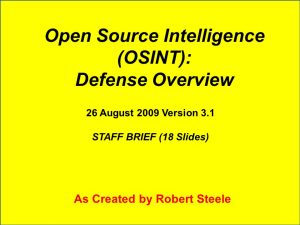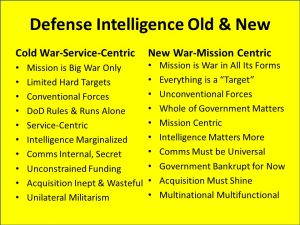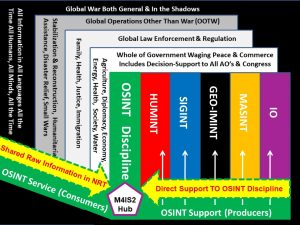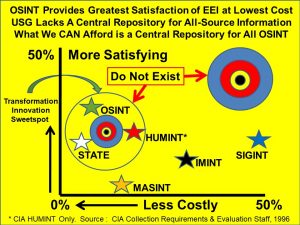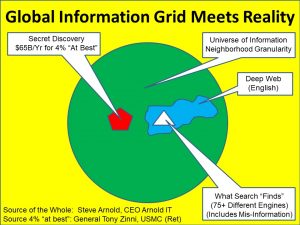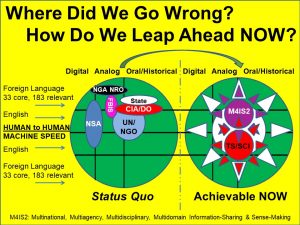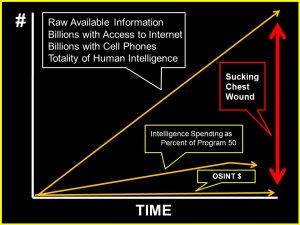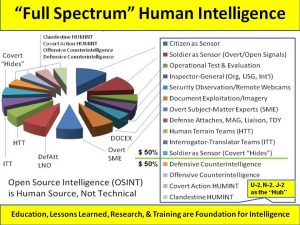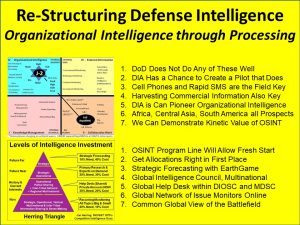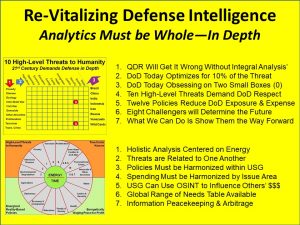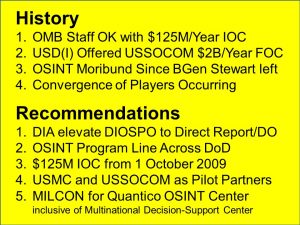SHORT URL: https://tinyurl.com/USDI-OSINT
I have sought to help USDI on multiple occasions, and failed every time. Here is the 2009 effort, with the assistance of Dr. Joseph Markowitz, who also failed to get CIA to take OSINT seriously.
- PPT (6 Pages): 2009 DoD OSINT Leadership Briefing
- PPT (18 Pages): 2009 DoD OSINT Staff Briefing
Complete briefings (graphics & script) below the fold.
LEADERSHIP BRIEFING (6 Graphics):
This is a draft briefing for DoD LEADERSHIP
This briefing contains speculative views on future directions in OSINT funding and contracting.
USD(I) and DIASPO are granted an unrestricted unlimited copyright for official government use only.
Military attaches of any nationality are granted an unrestricted unlimited copyright for official government use only, inclusive of information sharing discussions with the other seven host country “tribes” of intelligence.
The Quadrennial Defense Review affords us an opportunity to revisit strategy and priorities for Defense over-all, and also within Defense Intelligence.
At a very general level, but with particular reference to the new emerging priorities that represent a need for universal coverage at a neighborhood level of granularity, OSINT is not only the best solution for much of this, it is the only affordable, achievable solution.
Up to this point, Open Source Intelligence or OSINT has been full of contradictions and lacking in coherence.
Congressman Simmons drove the Army to define OSINT as a discipline, but it is not managed as such. Senator Simmons, if he wins in 2010 as is now projected, could have more to say on this.
A coherently managed OSINT Program would appear to offer substantive benefits for defense.
We cannot manage what we cannot measure.
Our best guess estimate of what DoD is spending on open sources and methods today is no less than $1 billion a year, to as much as $3 billion a year, if one includes all contractor procurements across all mission areas.
We recommend that USD(I) direct a series of very fast—30 day—reviews as depicted here.
At the same time, we have never sought to engage our defense coalition partners, and new potential military partners who might be willing to discuss sharing unclassified information.
We recommend that USD(I) staff a letter via normal channels to the accredited military attaches, seeking a military POC at the home country HQS level that we can begin to include in a global working group.
Here is a speculative forecast of key findings from the fast studies if ordered by the leadership.
Our recommended letter to all the military attaches is intended to allow a multinational working group to be formed in October as a means of ensuring that all that we do takes into account all that we can beg, borrow, or buy from foreign military partners.
STAFF BRIEFING (18 Graphics):
This is a draft briefing for DoD STAFF
This briefing contains speculative views on future directions in OSINT funding and contracting.
USD(I) and DIASPO are granted an unrestricted unlimited copyright for official government use only.
Military attaches of any nationality are granted an unrestricted unlimited copyright for official government use only, inclusive of information sharing discussions with the other seven host country “tribes” of intelligence.
We all know now that the Cold War is over and the Long War is now the context for defense thinking.
What most of us do not realize is that General Al Gray, then Commandant of the Marine Corps, got it right in 1988—on the strength of the findings of his new Marine Corps Intelligence Center (MCIC).
The “establishment” has ignored clear warnings and calls for defense reform—in policy, in acquisition, in intelligence, in operations—issued in 1988-1989, 1992, and 1998 when the “four forces after next” were clearly defined by the Army Strategy Conference of that year.
The purpose of this briefing is to suggest the way ahead for Defense Open Source Intelligence (OSINT), and to propose specific transformative innovations centered on Human Intelligence (HUMINT) and OSINT in partnership with the rest of the US Government and with our coalition military partners.
If adopted, these recommendations will firehose all possible open sources in all languages to the high side in near-real-time; and will allow for the provision of unclassified decision-support to Whole of Government as well as international Stabilization & Reconstruction Operations.
The U.S. Intelligence Community does not have an all-source processing center. Despite the emphasis on sharing, analysts are still spending an unreasonable amount of time accessing disparate data bases. Here are the officially defined relative values of the major disciplines including two open ones: OSINT such as it exists, and diplomatic reporting.
What we CAN do now, very inexpensively, is create a reliable defense open source intelligence center (DIOSC) with an embedded Multinational Decision-Support Center (MDSC) to achieve, at least at the unclassified level, the Holy Grail of direct timely access to all information in all languages all the time.
The green circle represents all that can be known in all languages that is relevant to national security and national competitiveness decision-making.
We are not doing well. “Search” is a variable with at least seventy-five major search engines, the most prominent of which will show you what someone else had paid for you to see.
Deep Web is in its infancy, but does not do much better, especially in languages other than English.
Isolated from this larger reality is the secret world.
We went wrong in following our obsessions–the Cold War produced denied areas that led to technology being substituted for human intelligence, which in turn exploded the secret world.
Our leadership has been an industrial-era leadership, content to “go along” and be satisfied with continuity of operations, while using secrecy to protect budget share and avoid accountability.
Our leadership has also been isolated, lacking in understanding of the art of the possible, and the urgency of the non-military threats to America.
Here is a view of the profound change in our information challenge–we are now at a point where we need to respect and understand individual human beings as the basic unit of measure in devising all of our policies as we seek to eradicate all ten threats to humanity and to our Republic.
This simplified chart sums up what has been amply demonstrated in study after study—there is an information explosion that is logrithmatic in nature, while our investment in information and communication technologies (ICT) has been arithmetic.
Our investment in OSINT has been vritually non-existent, running roughly at one half of one percent to no more than one percent of the total secret budget.
This is a sucking chest wound. USD(I) Actual and the Director of DIA need to pay attention NOW.
It merits comment:
1 )OSINT is a human collection discipline, not a technical processing sideshow. The sooner USD(I) and DIA get that right, the faster we can progress.
2) Clandestine and covert HUMINT desperately need an OSINT foundation to make the kind of advances now being called for.
3) DH could serve as a god-father to a new DIA Directorate, DO. The DO should be co-equal to and deeply in harmony with DH, DX, and DI.
There is no faster better way to make OSINT properly available to all policy, acquisition, and operations leaders and their staffs than by creating a Defense Open Source Intelligence Center. It should have embedded within it a Multinational Decision-Support Centre commanded by a foreign officer, able to produce unclassified decision support while also attracting all possible open source information from all affiliated countries.
This is a home run—a very large NRT feed to the high-side; diversified detailed OSINT for USG Whole of Government operations; AND stabilization and reconstruction, humanitarian assistance, and disaster relief decision support to the UN and NGOs. In return they give us access to their raw data. On top of this we use two way reach-back military-to-military in a new global grid that is mostly unclassified but can support secret and top secret riders.
This chart represents decades of engagement in both secret and commercial intelligence. Just look at it more simply as four quadrants and note the three arrows. Most of the world and certainly the USG is in Quadrant I, and doing badly.
The young digital natives are in Quadrant II, and conventional organizations fear what they do not understand here.
The best of the commercial intelligence firms have been in Quadrant III for over a decade, able to get “just enough, just in time” data from anyone anywhere.
Finally, we have Quadrant IV, no one is there that we know of, but this ideal has been recognized since Harold Wilensky wrote the book by this title, Organizational Intelligence, in 1967. A DIOSC can make all of this happen for DoD and DIA, safely and inexpensively. We can deliver to the high side; capture call cell phones as data entry devices; and channel unclassified inter-agency and coalition support via the J-2 of every command.
This slide was created by Jan Herring, the first National Intelligence Officer for Science & Technology (in the 1980’s), and today a partner in the Academy of Competitive Intelligence, which I recommend to all of you .
I use this slide to point out the the bulk of what we need to do our jobs is both inexpensive, and easy to share.
It also portrays a simple yet sophisticated means of assuing USD(I) and the Director of DIA that all four needs will be attended to and provided for in our planning, programming, and budgeting system.
This is my newest analytic model, inspired by the UN High-Level Panel on Threats and Challenges. The 12 core policy areas were culled from the last four or five Presidential transition team endeavors.
Finally I thought about what countries are certain to define the future on the basis of demography alone, and came up with these. Wild Cards are many, including Malaysia, Pakistan, and Turkey, the Congo and South Africa, and Denmark with respect to the emerging Northern resource arena.
In this context, focusing all of our intelligence and most of our defense acquisition on the two red zeros makes no sense at all.
I created this chart to illustrate how 21st Century analysis must be done, fully integrating an understanding of all the threats (for example, poverty does more environmental damage than willful corporations), and how all of the policies interact with one another and must be harmonized—for example, using water to flush oil tar and grow grain for fuel is about as foolish as anyone can get.
It’s all connected, it is time we start doing holistic analysis that REDUCES the burden on traditional defense by mounting a full-court press by Whole of Government to influence other people’s budgets and behavior in constructive ways.
This is the first of three slides oriented toward the Director of DIA.
HUMINT and OSINT are the center of gravity for the future of defense intelligence as well as the future of inter-agency and coalition intelligence. MASINT should become a bill payer while DIA moves its analytic cadre to the next level with vastly improved HUMINT-OSINT Outreach and virtual integration across all boundaries.
We have to recognize Organizational Intelligence as an objective, as the focus on our transformation and innovation. We can get there from here easily, all it requires is leadership and a shared mind-set. We are not processing nor do we have a processing mind-set that lends itself to one time data entry, universal access there-after.
Similarly, we must restructure to provide for all four of our defense intelligence needs areas. We have neglected the top three and do the fourth very badly. We can fix all four within 90-180 days.
Lastly, using defense intelligence analysts as the hub, we must create a new craft of intelligence analysis, of analytic tradecraft, that REDUCES the burden on defense by assuring holistic Whole of Government and Whole Earth warning as well as solid analysis to identify opportunities for what General Al Gray called “peaceful preventive measures.”
The stage is set. Joe Markowitz and Robert Steele visited OMB and Kathleen Peroff and her counterparts for State and Defense understand the deal. Sean O’Keefe, as DD/OMB, told Don Gessaman that $125M was a good IOC, and planned a Presidential Imitative before he moved to NASA and we lost ground.
Our recommendations are straight-forward. We can do this, we can do this fast, and we can do this very , very well.
All we need is two words: “Do It.”
See Also (updated 2014):
2013 Robert Steele: Reflections on Reform 2.3 Numbers for 30% DoD Cut over 2-4 Years
2013 Robert Steele Answers on OSINT to PhD Student in Denmark 2.0
2004 DoD OSINT Program: A Speculative Overview
NATO OSINT to OSE/M4IS2 Round-Up 2.0
OSINT Literature Review, Name Association, Lessons Learned
DOWNLOAD BRIEFINGS IF DESIRED:
PPT (6 Pages): 2009 DoD OSINT Leadership Briefing
PPT (18 Pages): 2009 DoD OSINT Staff Briefing









